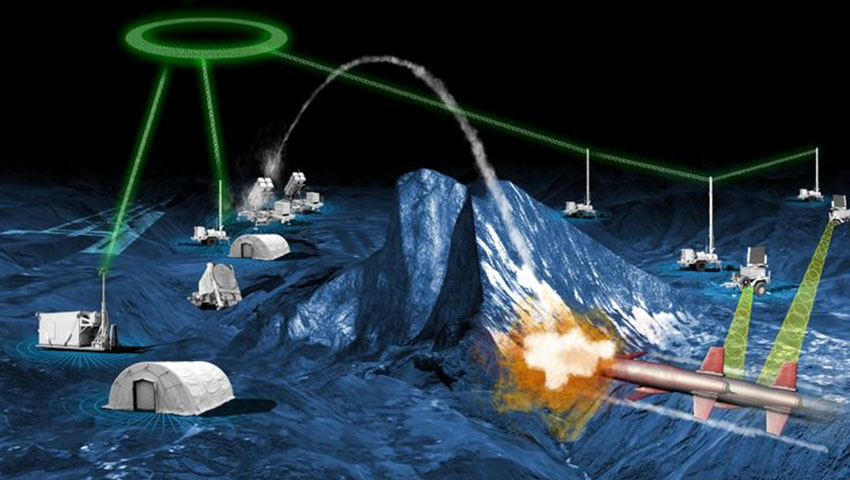Northrop Grumman has successfully demonstrated the capacity of the Integrated Air and Missile Defense Battle Command System incorporating the sensor suite of US Air Force F-35s, US Marine radars and Patriot missile batteries to simultaneously engage multiple threats mimicking real cruise missiles.
To continue reading the rest of this article, please log in.
Create free account to get unlimited news articles and more!
The sophisticated targets precisely mimic real cruise missile threats and can take advantage of this terrain to hide from the radars and sensors commanders have positioned in the area.
This can create gaps in tracking that make the job of interceptor missiles or other defensive weapons more difficult – you can’t hit what you can’t see.
Flight Test 5 (FT-5), the most sophisticated and difficult development test yet for the Army’s Integrated Air and Missile Defense (IAMD) Battle Command System (IBCS), developed by Northrop Grumman.
High above the range, sensors aboard US Air Force F-35 fighter aircraft see and acquire the two surrogate missiles.
IBCS integrates the aircraft sensor data with that of available ground sensors, including Sentinel, Patriot weapon system and US Marine Corps TPS-59 radars.
All share information via the IBCS Integrated Fire Control Network (IFCN). As one sensor loses sight of the threats – and each will at some point – the targets are acquired by other sensors on the IFCN, enabling IBCS to create a precise, uninterrupted composite track of each missile’s movements.
With data from every sensor, IBCS produces a single integrated air picture on the screens of the air defence soldiers at TAC-2.
Northrop Grumman IBCS program director Mark Rist said, “Without IBCS, all those different sensors operate independently, creating opportunities for threats to avoid detection as they fly to a target.
“Without being integrated onto a network, these sensors produce a more ambiguous, less-clear air picture, making engagements of threat systems more challenging.”
They see every change in altitude and direction as the two surrogate missiles paint tracks across their screens. Because IBCS enables joint weapons as well as joint sensors, the defenders at the controls can select the best effector to use against these targets.
Soldiers are about to launch two Patriot Advanced Capability 2 (PAC-2) interceptor missiles.
One, then another PAC-2 interceptor missile is launched by the soldiers. IBCS is not only able to launch the missiles, but also plays a critical role in the engagement by actively closing the fire control loop and providing in-flight updates as the PAC-2s converge on their targets.
The surrogate cruise missile targets are closing in and can now be seen on video in the control room – and then suddenly they can’t: One, then the other disappears in a ball of fire as the PAC-2s destroy them.
Rist added, “Information is ammunition, and IBCS is providing soldiers with more. We brought a lot of things together in this development test. It was the first including joint operations with the Air Force F-35 and Marine Corps radar systems, the first with Air Defense Artillery soldiers at the controls, and the first involving software developed using our Agile methodology.”
IBCS enables soldiers to be even more effective by integrating all the systems’ data and providing a common command-and-control (C2). Soldiers will only need to learn to use the IBCS C2, instead of spending time becoming specialists on only one or two of a dozen different sensor and weapon systems.
That enhances IBCS’s already impressive battlefield survivability, because soldiers will be capable of using any of the available sensors with any available weapon system at any command post connected to the self-connecting, self-healing IFCN.
Also, less time will be spent in recurrent training, making more time available for teaching operators defence strategy and how to fight. The IBCS 'every sensor; best effector' concept gives commanders greater flexibility in defence design, allowing them to position resources for greatest coverage in far less time essentially helping to change the way soldiers see and fight air battle.
Northrop Grumman’s open-architecture system-of-systems approach to IBCS eases the integration of any new or legacy sensor and effector systems, which is important for US joint operations and to foreign governments. Poland has an agreement with the US Army to purchase IBCS for modernisation of the nation’s WISLA medium-range air defence system, and other countries have expressed interest as well.
With the success of FT-5, Northrop Grumman will now focus on the Army’s Limited User Test planned for later this year, followed by the low-rate initial production and full-rate production phases of the system, to field IBCS to Army air defenders in fiscal year 2021.
Colonel Tony Behrens, Army Capability Manager for the Air and Missile Defence (AMD) Command, and a nearly 26-year career Air Defence Artillery (ADA) officer, said the Army must have the IBCS capabilities to be effective and successful in future combat operations.
“To me, it’s beyond critical,” he said. “We’re not just giving soldiers a new piece of equipment, a new piece of gear. We’re going to give them an entirely new way of operating on the battlefield that is so much more efficient. But it has to start with the system that enables you to do that.”
Brigadier General Brian Gibson, Director of the Army’s AMD Cross-Functional Team, expanded on COL Behrens comments, saying, “Enabling multi-domain – or more accurately, all-domain – operations is vital to ensuring battlefield advantage and superiority. When successfully fielded, IBCS will be one of the Army’s pathfinder capabilities into what is becoming a top priority for our military leaders: joint, all-domain command and control.”
IBCS may also be the Army’s first big step towards multi-domain convergence – the next level above integration.
Stephen Kuper
Steve has an extensive career across government, defence industry and advocacy, having previously worked for cabinet ministers at both Federal and State levels.

 Login
Login








